image from Field Guide to Candy
A few weeks back, I was invited to be a judge for TasteTV‘s Best Toffee in North America Competition. A whole boxful of toffees delivered to my door? Yes, please!
Those of you who are curious about the difference between toffee, English toffees, and buttercrunch, feel free to see my older post on buttercrunch. I became quite obsessed with untangling the various monikers of this candy while researching my candy book, if you couldn’t tell.
These days, most buttercrunch is marketed simply as “toffee”; I only saw one brand out of thirteen that was labelled “English toffee” (Which may perhaps provide some comfort to poor Brits trying to find their version of the candy abroad). For that reason, I will refer to all the candy I sampled for the competition as toffee, to avoid confusion. I will maintain, though, my abiding love for the word “buttercrunch”. If I ever make and sell my own version, I’ll call it buttercrunch, and probably confuse the heck out of everyone.
So how does one determine the best toffee?
I made a list of the various important qualities I could think of: thickness of the caramel, texture of the caramel, type of nuts, size of nuts, thickness of chocolate, chocolate on one or both sides, quality of chocolate, size of pieces…the list could go on and on, and obviously everyone will have his or her own
After tasting all the contestants, I came to the following conclusions about what makes an excellent toffee:
Caramel: Smooth, buttery, and rich, dry and shiny appearance (not greasy or dull), with a clean snap. I believe this style of toffee should be brittle, not chewy. The challenges here are to find the best proportions of sugar and butter and the ideal cooking time to create a robust, sweet caramel flavor and a pleasing, crumbly texture. This is probably the biggest challenge for toffee makers, as too-hard or mushy caramel can totally break the enjoyment of a piece of toffee. The sensitivity of caramel to humidity also means this is often the first component of toffee to go off. Eat your toffee fresh, and posthaste.
Chocolate: Dark or milk seems to be a matter of a personal preference; I see plenty of both types. I favor dark, as I find the bitterness helps counteract the sweetness of the caramel. Even though toffee is a candy, I find the most successful versions combine the three main components of caramel, chocolate, and nuts well so they all enhance and play off each other, yet also remain distinctive, instead of blending into a one-dimensional sugary continuum.
Nuts: Almonds are the traditional topping, but almost anything goes these days: pecans, walnuts, peanuts, and others. Some worked better than others, but I found that the size of the nuts made the biggest difference. Some toffees were topped with larger nut pieces: this is what I call the “Almond Roca” style of toffee, which is crunchy and leads to more rough-hewn pieces breaking off in your mouth. At the other end of the spectrum, you have very fine “nut dust” sprinkled over the toffee, so you get the flavor but almost no nutty crunch – the focus is on the caramel texture instead. Likely you have your own opinion as to the ideal nuttiness of your favorite toffee.
Flavor Synergy: The combination of the three primary ingredients into a greater-than-the-sum-of-it-parts whole. A truly transcendent toffee makes the alchemy between caramel, chocolate, and nuts obvious and unarguably magical. It’s a careful balancing act to keep one element from overwhelming or clashing with the others. When you taste a good toffee, you know: all the components are separate but come together, enhancing each other. I could eat through a whole box of my favorite toffees with no self-restraint and no regret. Eating too much mediocre toffee gives me the same feeling when I binge on sugary Halloween candy: I wonder why I wasted all those calories and got no satisfaction.
You can see the results of the Best Toffee in North America Competition here. Following are some of my personal favorites from the taste testing:
Toffee Talk: This toffee has my favorite caramel: when you bite into it, it snaps perfectly. The texture and thickness of the caramel makes how it shears off in your mouth pure pleasure. When I first looked at it, I thought it was surprisingly thick – and it would have been unpleasant if the caramel was too hard. But in fact, it is precisely the right depth to draw out the experience of biting through the toffee. I also really like that the nuts are a sprinkling of fine dust, with larger pieces embedded in the caramel; it allows you to bite through the top chocolate layer and get to the caramel with no textural distractions.
Toffeeology: This toffee has what I consider the classic construction: a medium-thin layer of caramel sandwiched between two layers of chocolate and nuts. The caramel is just slightly chewy in the finish, but the chocolate and nuts are excellent and full flavored. An excellent, traditional rendition. It comes in dark and milk chocolate versions, but I prefer the dark one. I also love the name.
Malibu Toffee: This toffee is “Almond Roca” style toffee – covered in finely chopped nuts, so you get a strong nutty crunch before you hit the caramel center. The caramel is pleasantly, mildly sweet – it acts more as a background for the nuts and chocolate here. If you are into crunchy toppings – someone who doesn’t forego peanuts on their ice cream sundae – this might be your kind of toffee.
Cinda’s Toffee: Just so I’m not accused of total dark-chocolate bias, this toffee also made my favorites list It’s lighter and less intense than some of the other above, but I loved the mild, sweet, butter flavor of the caramel. The milk chocolate and the roasted almonds worked really well with the caramel for a delicate but very satisfying taste. A great example of every component coming together wonderfully.
Hope all the toffee whetted your tastebuds for Halloween! If you’re not fully stocked up on candy bars already, you can also try this recipe for almond toffee bites from my candy cookbook. Happy Halloween!
- 1 1/2 cups (10 1/2 oz) sugar
- 1/2 cup (4 oz) unsalted butter, cut into pieces
- 1/2 teaspoon salt
- 1 teaspoon vanilla extract
- 1 cup almonds, toasted and finely chopped
- 12 oz milk chocolate, roughly chopped
- 2 cups almonds, toasted and finely chopped
- Line an 8x10 baking sheet with a silicone baking mat.
- Melt butter in a saucepan over medium heat. Add sugar, 2 tablespoons water, and salt. Stir occasionally until it comes to a boil.
- Continue cooking without stirring until the mixture reaches 290 degrees F.
- Remove from heat and add in vanilla and 1 cup almonds.
- Spread out mixture on the baking sheet. Let set for about 45 minutes, until mixture is set but still pliable. Score into rectangles.
- Break sheet of toffee into individual pieces.
- Melt and temper chocolate. (If you don't want to temper the chocolate, you don't have to, but the resulting candy will be softer and should be refrigerated).
- Place remaining 2 cups chopped almonds in a large bowl. Line a baking sheet with parchment or wax paper.
- Dip toffee pieces in chocolate and then roll in chopped almonds. Place on baking sheet and let set before eating or wrapping.
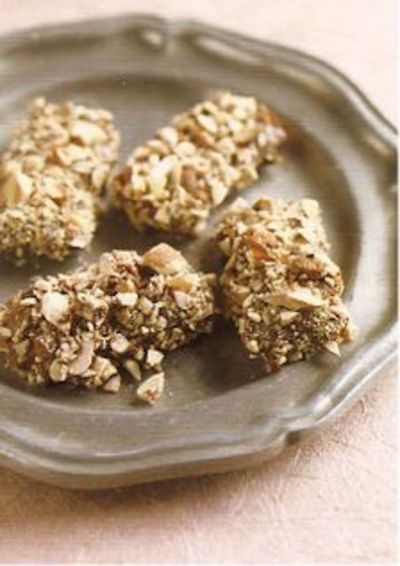
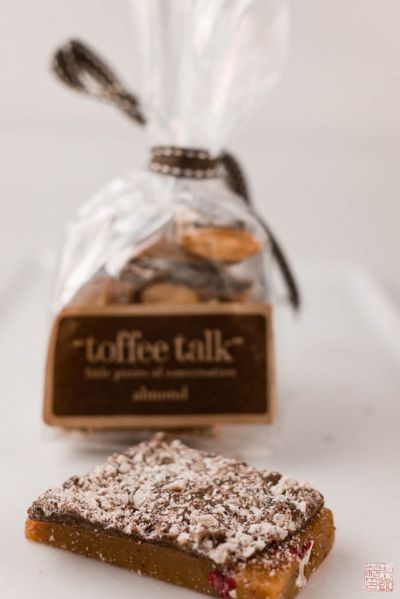
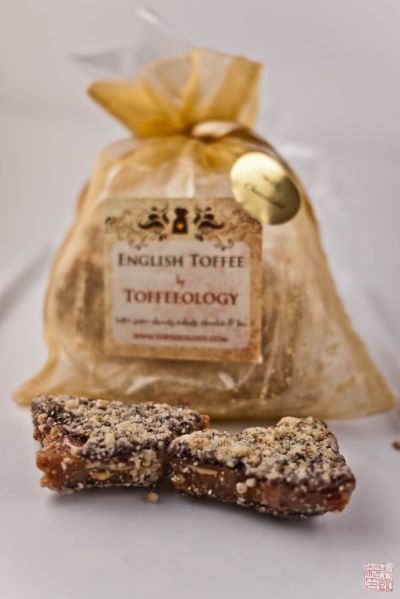
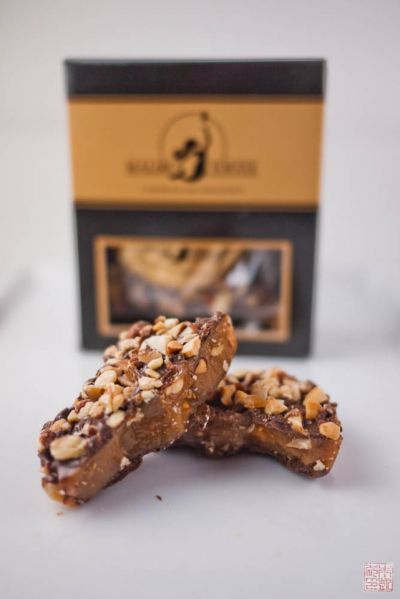
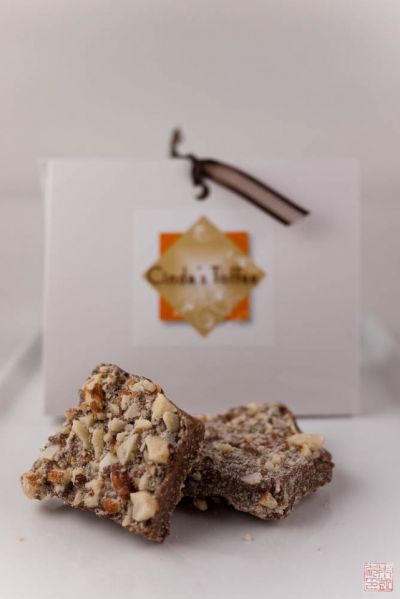


I love toffee. I make it every year as part of a box of chocolates for my family members :).
What a sweet gig to get! I’m totally craving toffee now!
Oh me! Oh my! Nice insights you have here. I love toffee btw…
Thank you for fulfilling my toffee cravings 🙂
I love the toffee from Vosges Haut Chocolat!
Oh my, thats so much toffee to handle! I’m quite impress – if it were me I would’ve gone into a diabetic coma at the four tasting.
love toffee . therefore i love this post.
Correction needed! In the recipe you say:
“Melt butter in a saucepan over medium heat. Add butter and salt. Stir occasionally until if comes to a boil.”
Since butter and butter and salt will NOT come to the hard crack stage, I think that needs to read:
“Melt butter in a saucepan over medium heat. Add SUGAR and salt. Stir occasionally until if comes to a boil.”
(I make my toffee in the microwave . . . much easier, just as delicious!)
Thanks for a great article.
Hi Penandra,
Thanks for the correction – I did indeed have butter twice by accident. Although the mixture will not reach hard crack, I do want to have it cook long enough to turn a nice dark color, which is why I gave a temperature.
Thanks,
Anita
We come from a big toffee family. Mum is a huge fan of it and I just make her happy by buying her a packet of toffees. Great to see the different kinds of toffee
That was so interesting. My hubby loves toffee, but maybe he really likes buttercrunch! I love that name too.
I looove toffee! Reminds me of Almond Roca, which I grew up with, but can not get where I’m living.
These looks Amazing!! Yum Yuuum
wonderful tips. This recipe looks simple and easy to make/ I would love to give it a try. Thank you for sharing this great info!
Toffee is great! Especially around the holidays. I can’t wait to try the recipe!
I love this recipe and made it a few times. However there is sometimes the toffee get crumbly after I stir in the chopped almonds. May I know what caused this happen ?
Hi Carri,
I’m not sure if I’ve had that problem before. When you say crumbly I think that maybe some crystallization occurred, which might happen when the toffee mixture is stirred too much and sugar crystals start forming. Have you tried stirring in the almonds slowly and gently to see if that makes a difference? Also check to make sure that you’ve cooked your sugar to the right temperature before adding in the other ingredients – undercooked sugar might also be more likely to crystallize. Hope that helps!